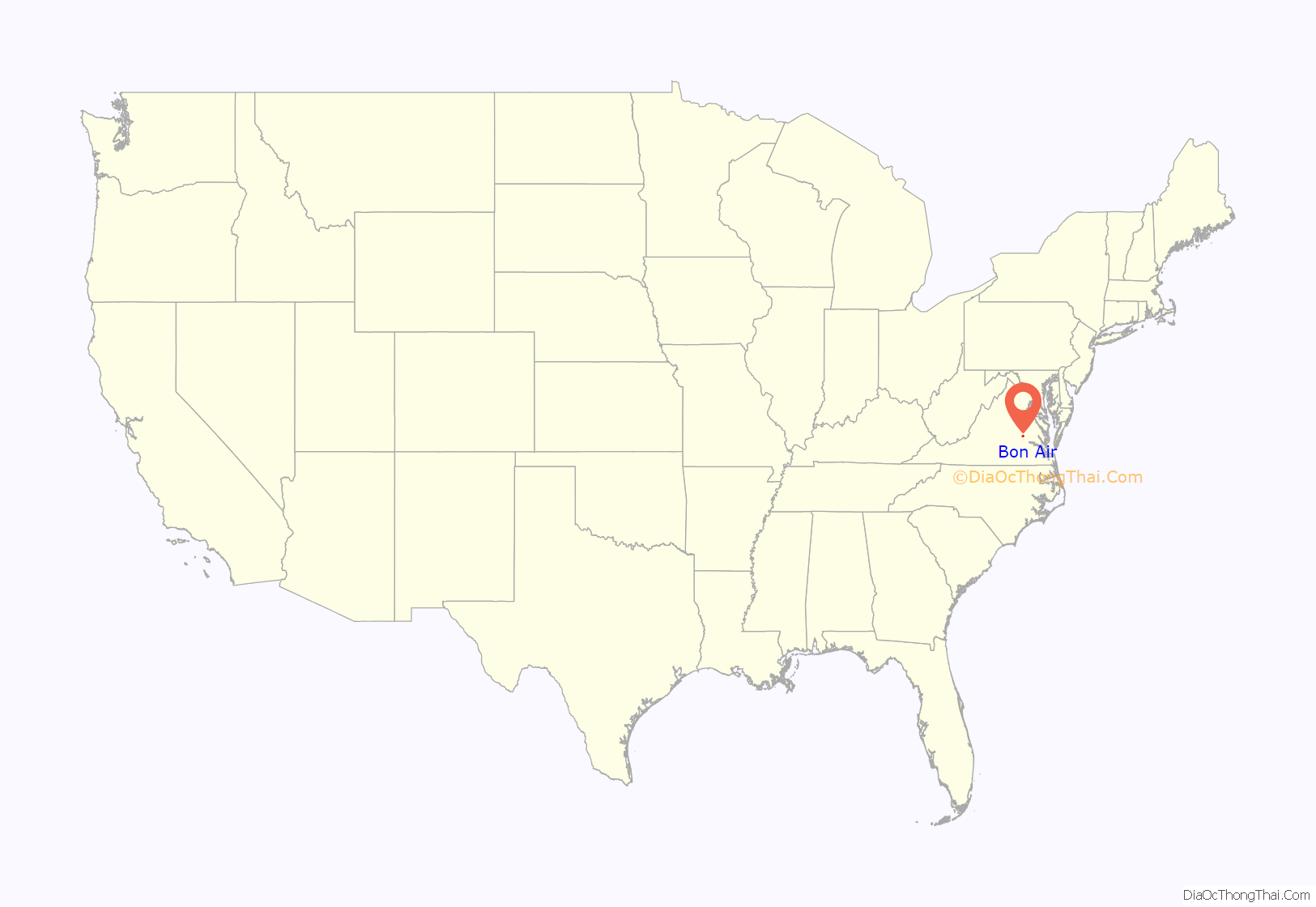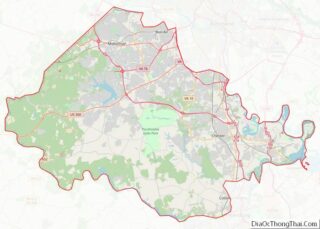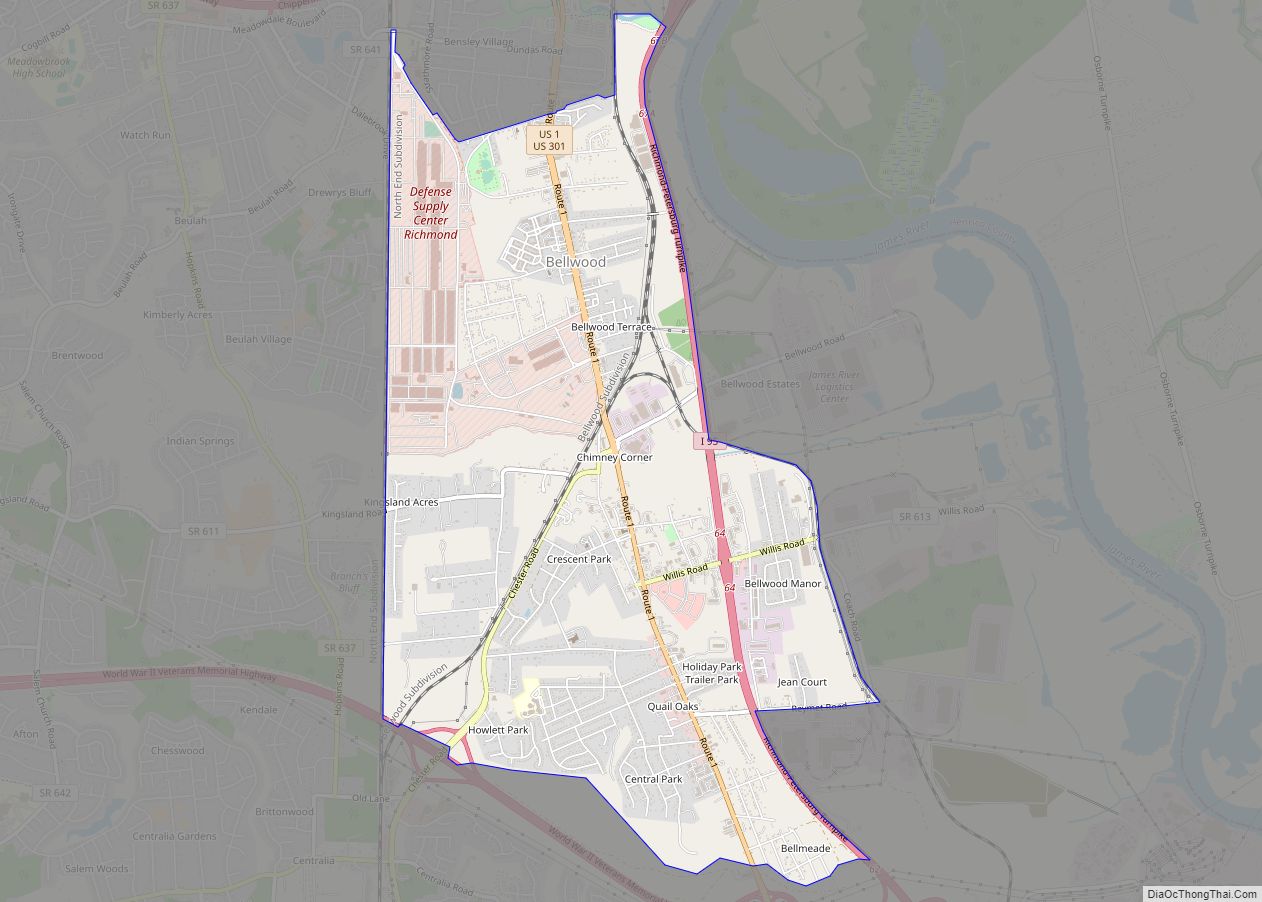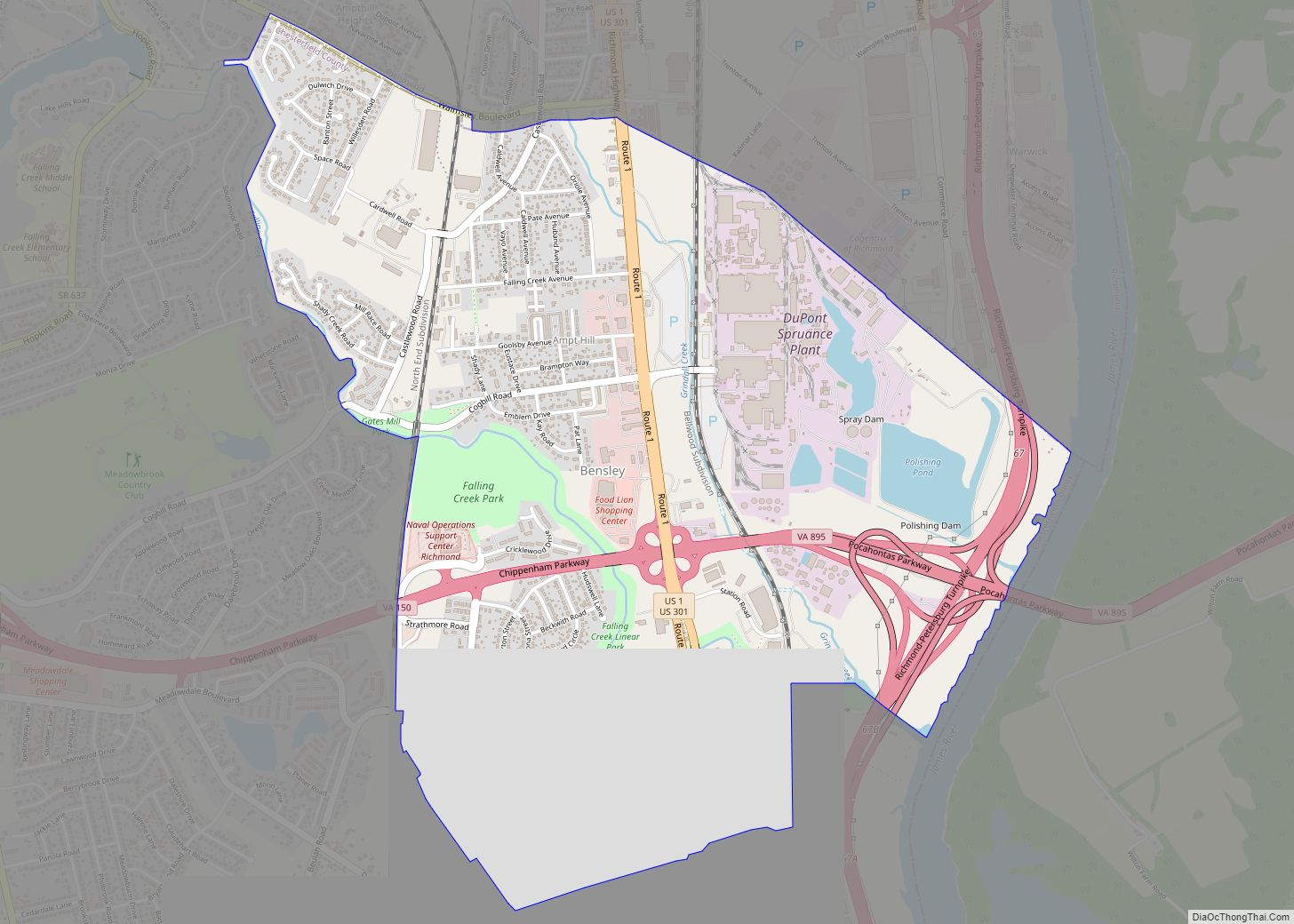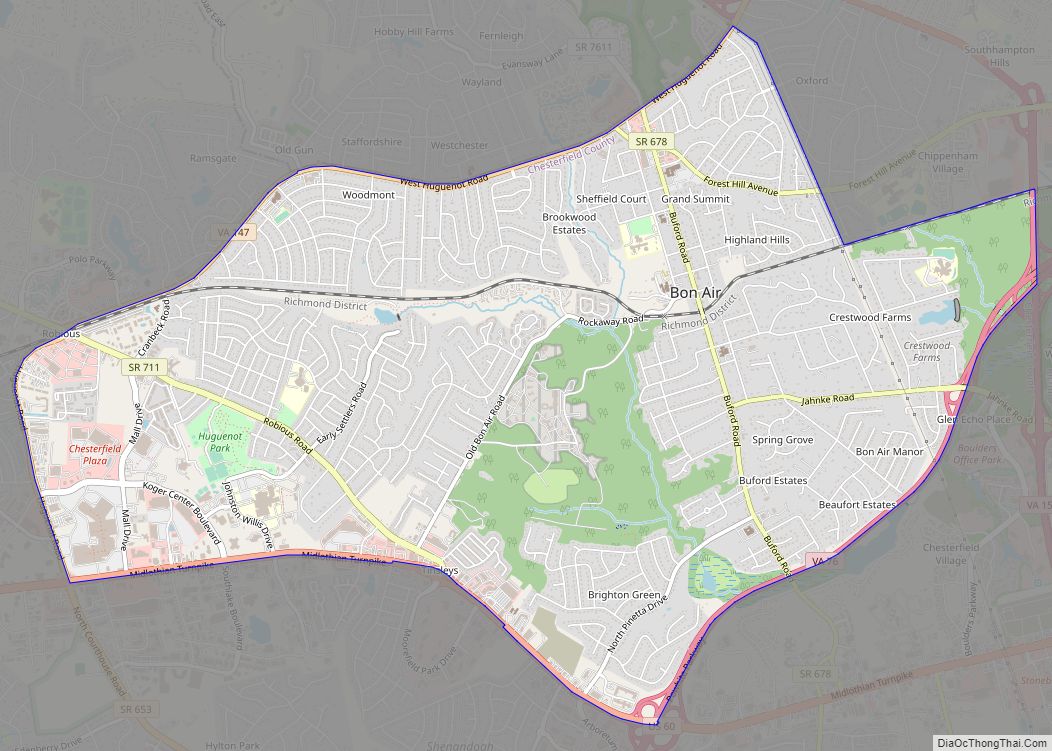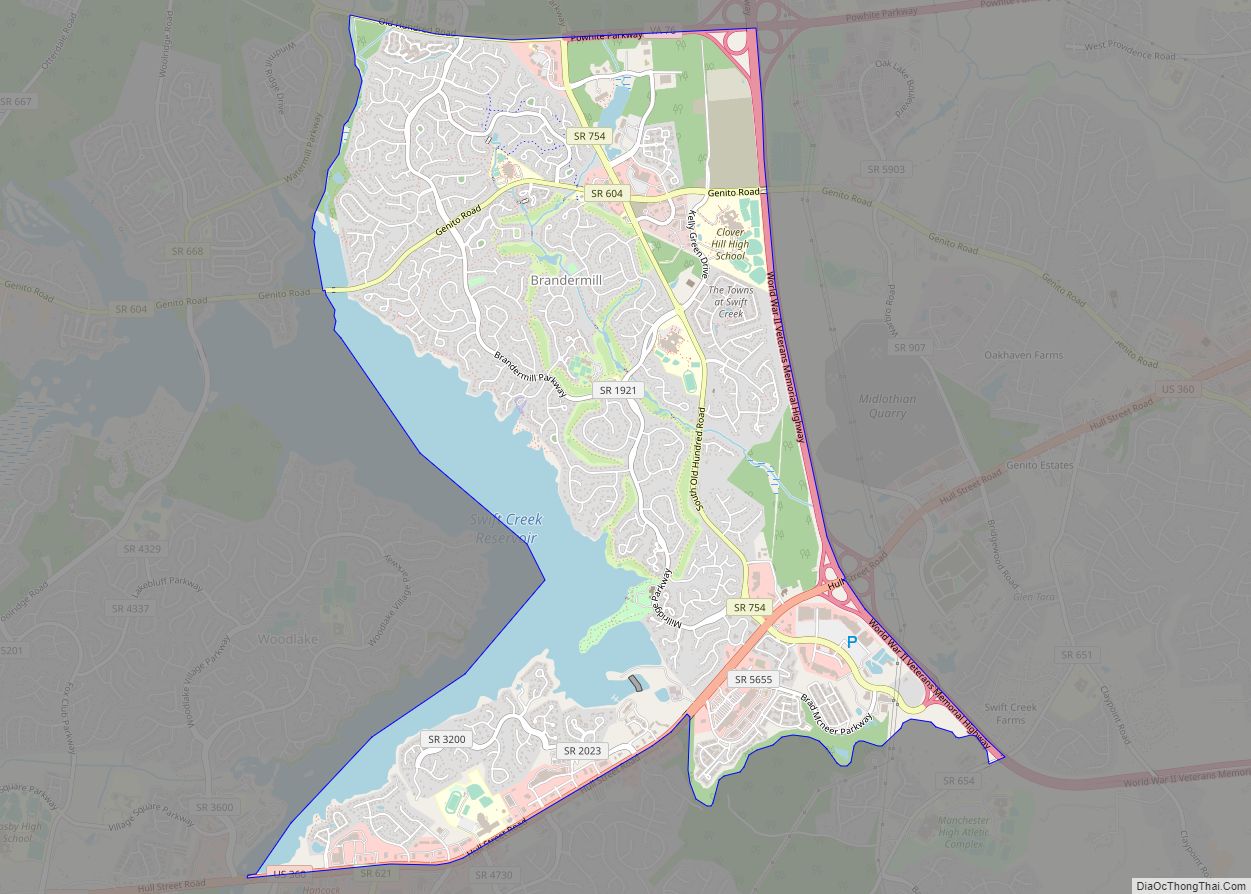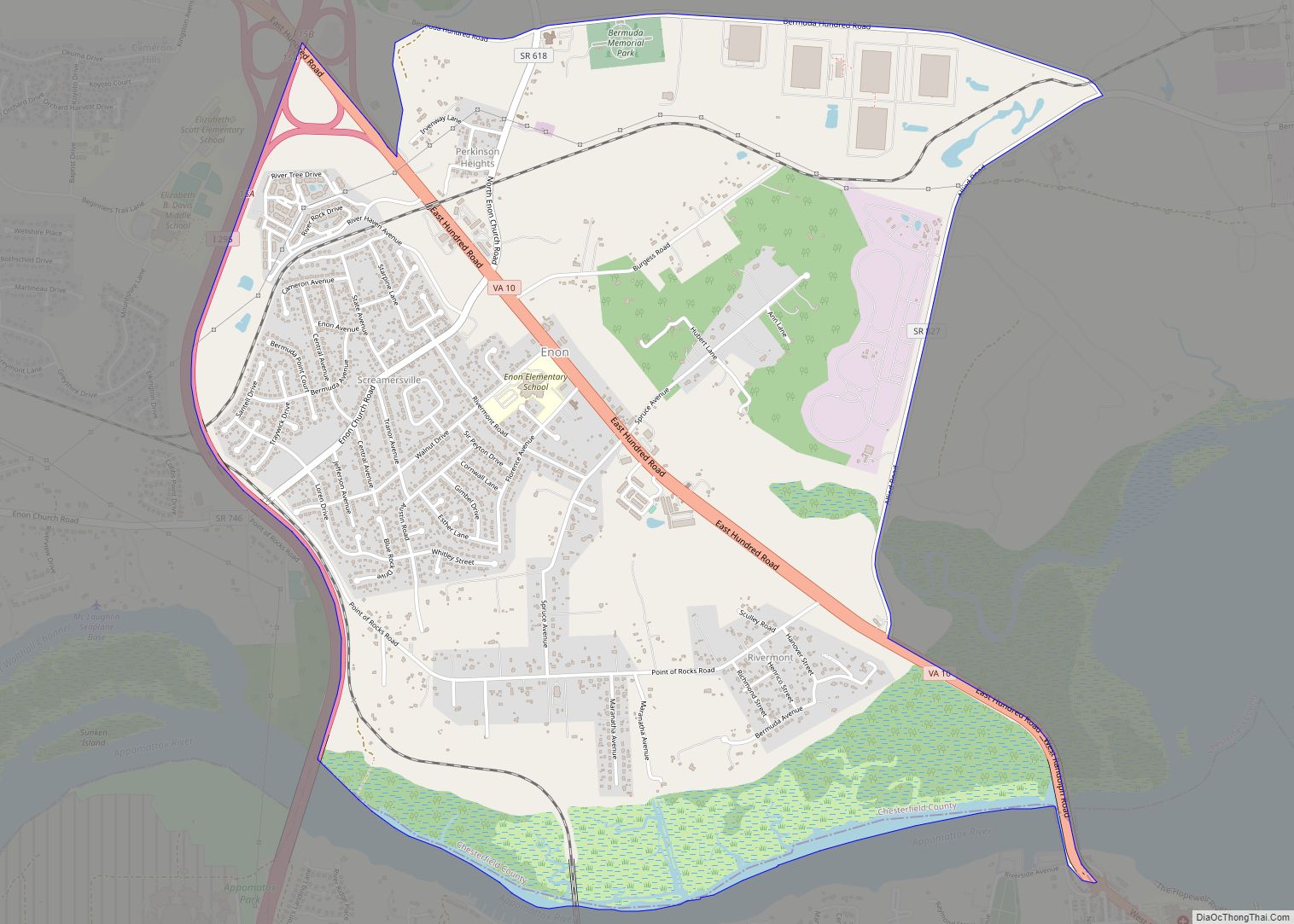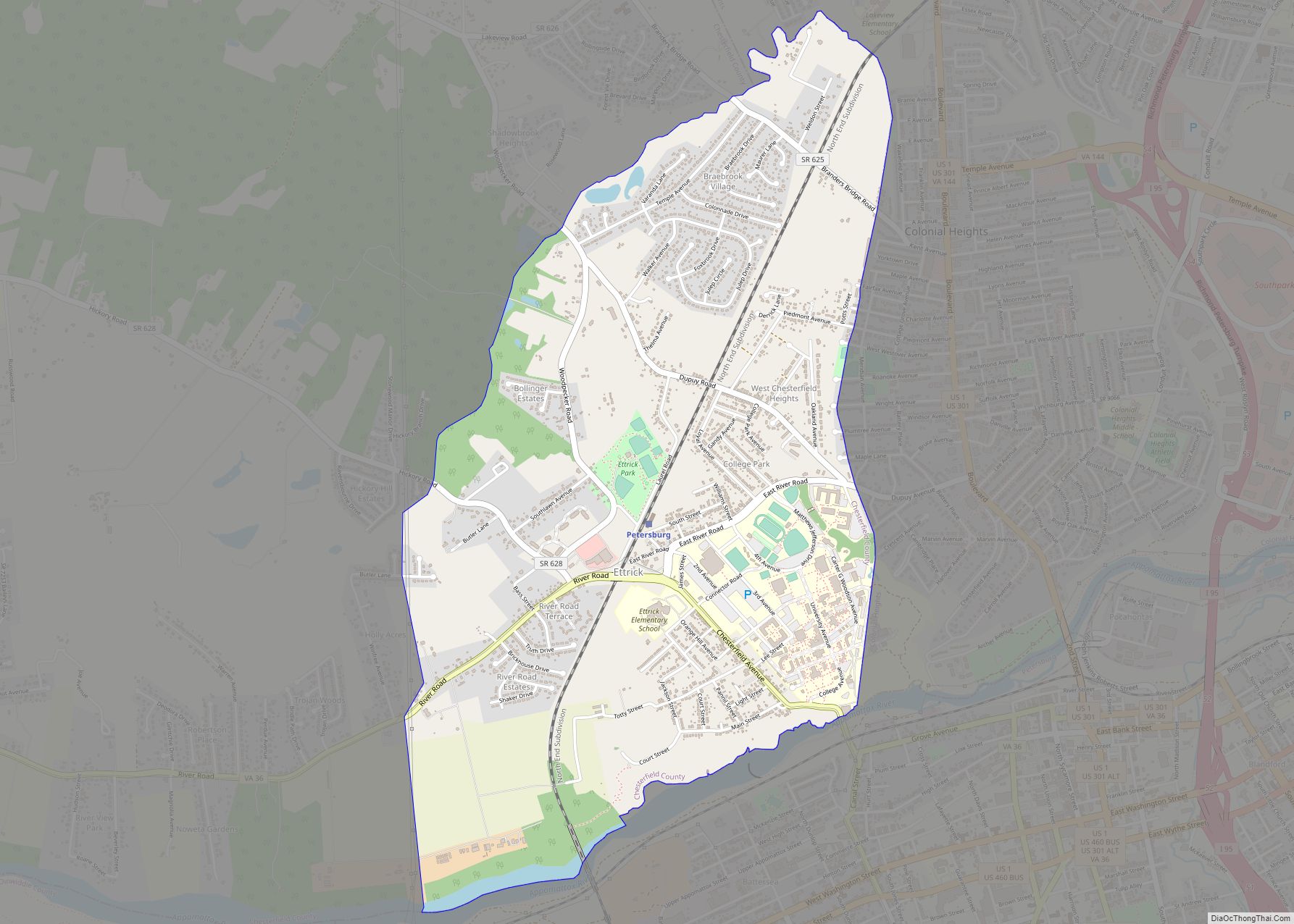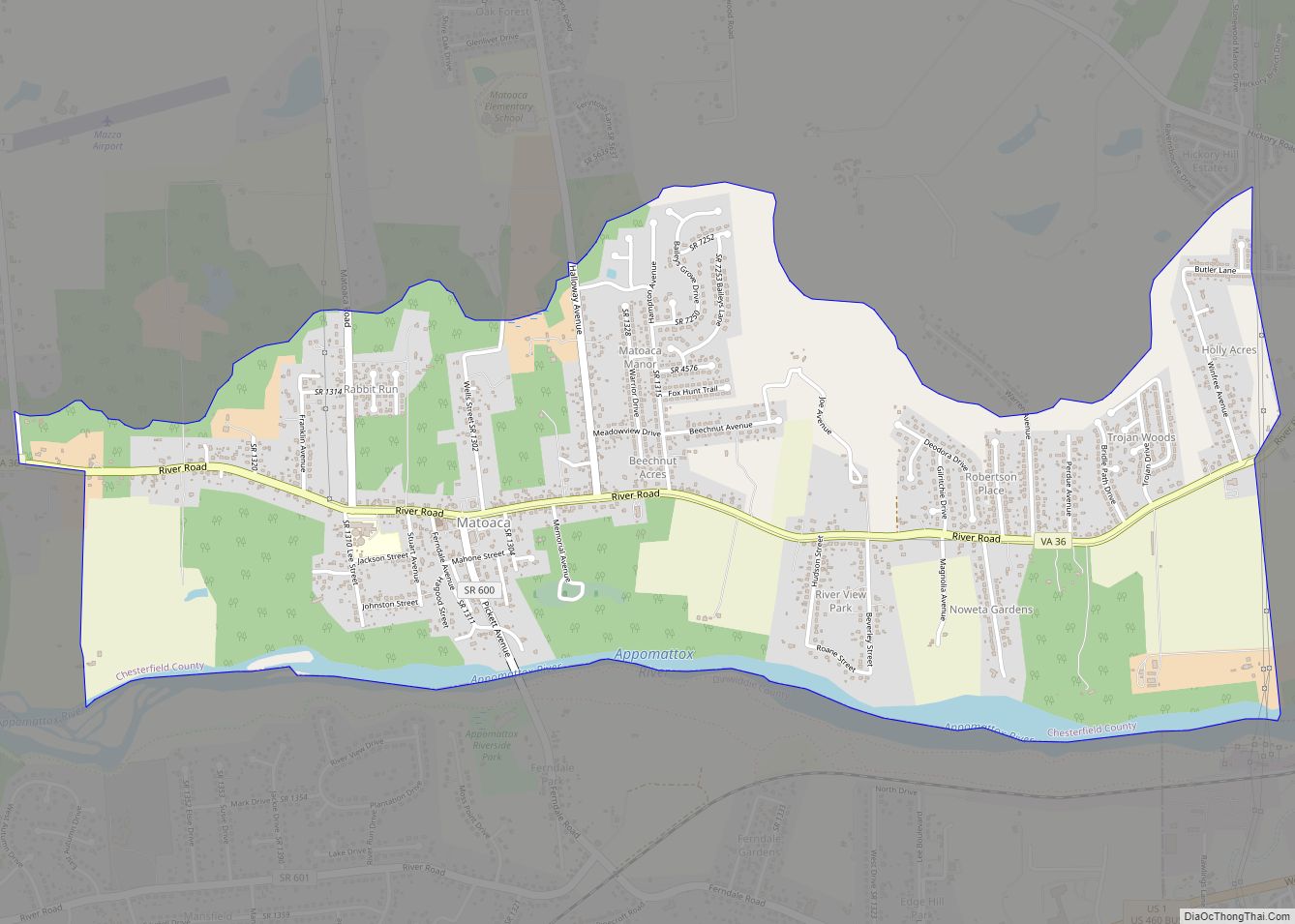Bon Air is a census-designated place (CDP) in Chesterfield County, Virginia, United States. The population was 18,022 at the 2020 census. The community is considered a suburb of the independent city of Richmond in the Richmond-Petersburg region and is a part of the Southside neighborhoods. Originally developed as a resort, a central portion of Bon Air has been designated as a National Historic District with many structures of Victorian design from the late 19th and early 20th centuries. Its name means “good air,” reflecting its role as a resort getaway that wealthy Richmonders enjoyed for its fresh air as opposed to the dirty air of Richmond’s industrial downtown of the late 19th century.
| Name: | Bon Air CDP |
|---|---|
| LSAD Code: | 57 |
| LSAD Description: | CDP (suffix) |
| State: | Virginia |
| County: | Chesterfield County |
| Elevation: | 328 ft (100 m) |
| Total Area: | 8.3 sq mi (21.6 km²) |
| Land Area: | 8.3 sq mi (21.6 km²) |
| Water Area: | 0.04 sq mi (0.1 km²) |
| Total Population: | 18,022 |
| Population Density: | 2,200/sq mi (830/km²) |
| ZIP code: | 23235 |
| Area code: | 804 |
| FIPS code: | 5108472 |
| GNISfeature ID: | 1492605 |
Online Interactive Map
Click on ![]() to view map in "full screen" mode.
to view map in "full screen" mode.
Bon Air location map. Where is Bon Air CDP?
History
Pre-resort settlement
Prior to the advent of the 1877 resort in Bon Air, the area had some settlements. Brown Road and Belleau Drive each follow portions of the old Warwick Road that dates back to the 18th century Warwick plantation. The Bon Air area came to be known as Brown’s Summit, probably named for the Brown family farm which was located near the southwest corner of present-day intersection of Jahnke Road and Brown Road.
In the first half of the 18th century, Anderson Edwards owned a large plantation on the current site of Bon Air. He sold parts of it to Nathaniel and James Duval in 1840. The Duvals’ two portions of Anderson Edwards’ land would eventually comprise large parts of modern-day Bon Air.
The R&D railway came through the area around 1850, connecting Manchester to Robious and the Coal Mines. An 1864 map shows a small cluster of buildings labeled “Pawhite Stop” on the “Railroad to Coal Mines” line near the site of historic Bon Air village. Another Civil War era map shows an area owned by “Cogbill” which is in the vicinity of the area near Buford Road near current day Bon Air Elementary School and Grand Summit subdivision. Early maps also lists a “Powhite Station” 1/2 mile east of Robiou’s Station.
Bon Air: the resort era
In the 19th century, it was believed that the higher elevation and distance from the urban area of Richmond provided a more healthful atmosphere, particularly in the hot summer months in central Virginia. With its nearby location and greater elevation, Bon Air offered these features nearby, and was founded as a summer resort town about 8 miles (13 km) outside of Richmond by railroad. One of the founders was Colonel Algernon S. Buford, of Chatham, Virginia, who is best known for his presidency of the Richmond and Danville Railroad during its massive postwar expansion, which ended in 1894 with the formation of the Southern Railway System (now part of Norfolk Southern). Bon Air’s connections with the railroad’s leaders could possibly be evidenced by the fact that over many of the years until passenger service ended in 1957, the community simultaneously had three stops within 1-mile (2 km) of trackage.
Colonel Buford was a graduate of the University of Virginia. He became a lawyer, and represented Pittsylvania County in the Virginia House of Delegates during 1853 and 1854. During the Civil War, Buford served the Confederacy in Richmond at Virginia Depot, although the title “Colonel” is believed to have been honorary, a southern custom common in the post-slavery years. With the support of Virginia Governor Francis H. Pierpont, on September 13, 1865, Buford became president of the 140-mile (225 km) Richmond and Danville Railroad (R&D).
Around 1875, Buford purchased portions of a large tract of land from Nathaniel and James Duval, a tract of land on the south side of the R&D right-of-way known as the old Anderson Edwards plantation. He personally (as well as through the R&D Railroad) helped in the development of Brown’s Summit, which was renamed Grand Summit, then Bon Air, after the French expression for “good air”. This choice may also have been related to the earlier settlement by French Huguenots, a group of religious refugees, slightly to the west. In 1877, Richmond jeweler Lewis G. Jahnke bought the other 153-acre portion of the Edwards estate from the Duval brothers and two years later sold this farm it to his brother A. Franz Jahnke Sr. This 350-acre estate, at 7737 Jahnke Road, would be known as Shady Echo. The Jahnke family, including jeweler Minnie Jahnke, were very involved in Bon Air life, from the fledgling Bon Air Presbyterian Church to the Bon Air Chautauqua Society founded by Reverend Hazen in 1885.
In 1877, Buford was among the first investors and officers in the Bon Air Land and Improvement Company. Other R&D officials involved in the development of Bon Air were General Thomas M. Logan, Andrew Talcott, and his son, Thomas Mann Randolph Talcott. In addition to these names, other early settlers contributed their names to the roads within the old Bon Air village. Col. Buford is honored by the naming of the thoroughfare Buford Road in Bon Air. Logan Street is named for General Logan. Polk Street is named for Bon Air resident Polk Miller, a pharmacist and highly acclaimed banjo player who founded what became Sergeant’s Pet Care Products while creating treatments for his favorite hunting dog, Sergeant. Other prominent residents included Dr. Hunter McGuire who was affiliated with the Medical College of Virginia and several other important hospitals and medical schools (and for whom McGuire Veterans Administration Medical Center in Richmond was named), his wife Mary Stuart McGuire, and their 10 children, many of whom also went into the field of medicine.
In 1889, the 165-acre (0.7 km) tract (with an antebellum farmhouse which was earlier known as “The Old Burton Place”) was purchased by J.R.F. Burroughs, a Confederate civil war veteran from Lynchburg, (then in Campbell County), and his wife Lucy. A childless couple, a few years later the Burroughs opened an orphanage which was originally called “The Home for Friendless Children”, and was incorporated in 1898. Religiously devout, the couple never solicited for funds for the orphanage, but there are tales of the support they received anyway. When Mr. Burroughs died in 1915, he was buried at a site now surrounded by neighboring apartments, where his tombstone reads “Faithful unto Death”. Burroughs Street in Bon Air was named for the couple.
Rail continued to serve as the primary means of transportation to and from Bon Air until the automobile era. The original Southern Railway Station was a building brought to Bon Air from the International Cotton Exposition which had been held in Atlanta, Georgia, in 1881. (This station was replaced in 1917, and portions of the original station were used in an old home on the south side of the tracks, still existent in 2005). Other early stops in the Bon Air area include “The Steps”, located on the north side of the tracks near the current Buford Road Bridge, a stop for the Bon Air Inn south of the Inn site on Burroughs Street, and a stop near the current subdivision of Woodmont for the Wherry Farm. This latter station was the only private station on this section of the railroad and was known as Lee Park. The early railroad alignment through Bon Air may have been to take advantage of a kaolin clay mine said to have been located on the south side of the tracks near the current Buford Road bridge. A plant built in Manchester to process the clay from Bon Air burned before it could go into production, ending the project.
Village period
In the 20th century, as the residential area around Richmond grew, Bon Air evolved into a middle-class neighborhood, occupied year round versus just being a summer resort.
The oldest lending Library in Chesterfield County was built in 1902 by the Bon Air Association as a Memorial to Dr. James K. Hazen, minister of Bon Air Presbyterian Church and a literary and educational leader of the community.
In 1911, the new Westham Bridge crossed the James River between Henrico County and Chesterfield County about 7 miles (11 km) upstream from Richmond. Built as a toll bridge, it was named for the nearby Westham Station of the Chesapeake and Ohio Railway in 1911. The privately owned Westham Bridge was financed by a group headed by developer George Craghead Gregory, who resided at Granite Hall, an estate about a mile from Williams Dam, where he had a mansion erected which was faced with stone quarried nearby. Gregory was also involved with plans to extend a streetcar line from an existing line at Westhampton Park (now the University of Richmond) to Bon Air, which he saw as becoming a “bedroom community” of Richmond. Between the James River and Bon Air, Gregory controlled large land areas along the proposed rail line which he hoped to develop. However, despite his plans, aside from grading of right-of-way all the way from the Westham Bridge to Bon Air, Gregory’s planned streetcar line did not materialize. This may have been due to weight issues at the Westham Bridge and/or right-of-way matters in Henrico County. However, portions of the planned and partially improved route can be seen in modern times with the gentle slopes found on present-day Southampton Road and along Mohawk Drive.
After Burroughs died in 1915, the Bethany Home was taken over by others, including Bon Air Presbyterian Church, until the home closed for good during the 1940s. Over a thousand children had known the farm as “home”, maintaining an average of 50 boys and girls at a time.
After 1933, State Route 147 was routed across the Westham Bridge. It connected River Road and Westham Parkway in Henrico with Southampton Road and the new Huguenot Road in Chesterfield. In 1950, the Westham Bridge, which had been subject to flooding and was inadequate for traffic in the growing suburban area, was replaced by the new Huguenot Memorial Bridge (named in honor of the French Huguenot settlers who came to the area in the eighteenth century to escape religious persecution in France).
The old bridge was dismantled, but the abutments were still visible at each end, and overhead power and telephone lines continued to mark the route for many years. Traces of the old streetcar right-of-way may be seen along gently sloped Southampton Road and Mohawk Drive near Forest Hill Avenue (which was formerly known as Granite Road), and on Logan Street and Hazen Street in Bon Air, where a washboard surface was long rumored by local lore to be the remnants of the streetcar project. Gregory’s old mansion, Granite Hall, now located in the Cherokee Estates subdivision near Williams Dam, was still in use as a private residence in 2008. The C&O’s Westham Station was relocated to a Richmond city park at Robin Hood Road and Hermitage Road in 1961.
1950s Suburban Development Boom
By the mid-1950s, Bon Air experienced a suburban population boom. The Bon Air Shopping center was built at Buford and Forest Hill Ave, and subdivisions like Crestwood Farms, Highland Hills, Brighton Green, and Brookwood Estates welcomed new residents. The burgeoning population also resulted in infrastructure and civic amenities being built. The Highland Hills community consisted mainly of pre-fabricated, contemporary (now described as “mid-century modern”) homes designed by noted architect Charles M. Goodman for National Homes Corporation.
Bon Air’s elementary school was already in its second home, but most high school students had to travel to Manchester or Midlothian high schools. In the 1960s, a new high school and later a middle school were built by Chesterfield County Public Schools on part of the former Bethany home property. Huguenot High School opened on September 6, 1960. The first principal was G. H. (Gurney Holland) Reid, a longtime principal of Manchester High School, for whom G. H. Reid Elementary School in another section of the county had been named. A fourteen classroom addition was completed around 1964. G. H. Reid retired at the end of the 1968–69 school year, the last before the city annexed the land occupied by the school the following January 1. Also on the former Burroughs land, Fred D. Thompson Middle School, named for a long-time county educator, was completed in 1965, and was one of the first county schools feature central air conditioning.
The Southern Railway ended commuter service to Richmond in 1957, and the Bon Air station was dismantled.
In 1967 Chesterfield County began to operate the Hazen Library and moved the location in 1975, according to a plaque on the building.
1970 Richmond-Chesterfield annexation
A portion of what was then considered Bon Air was annexed by the City of Richmond in 1970. In the Bon Air area, Huguenot High School, Thompson Middle School, and J.B. Fisher Elementary School (named for a Midlothian-area physician) were among approximately a dozen schools, support buildings, and future school sites conveyed to the City of Richmond along with 23 square miles (60 km) of territory as the result of a compromise negotiated during the annexation suit by the City of Richmond against Chesterfield County in the late 1960s. The annexation became effective January 1, 1970. The original Bon Air Elementary School and the newer building and Bon Air Primary School were allowed to remain in the county.
1970s – present: Additional Suburbanization and Historic Preservation of Bon Air
When Chippenham Parkway was built, construction severed the old Warwick Road route in the mid-1960s when it was built between present-day Jahnke Road and Midlothian Turnpike.
As Bon Air became increasingly suburbanized, Mary Anne Claflin published a 144-page book documenting Bon Air called “Bon Air: A History” in 1977, the Bon Air Historical Society was founded in 1978, and in 1988 the society assisted in generating an application for the Bon Air Historic District submitted to the National Register of Historic Places.
In 1987, The traffic patterns changed when the Powhite Parkway Extension cut across southern Bon Air from Chippenham Parkway to Jahnke Road on Midlothian Turnpike. Further, when the Willey Bridge opened in 1988 near Bon Air, Southsiders had significantly improved ability to access the West End of Richmond. In 1985, the Stony Point Shopping Center opened, anchored by a Ukrops store. The 1990s, Arboretum and The Boulders office park developments popped up south of Bon Air, and the Shoppes at Bellgrade (northwest of Bon Air) opened in 1990. The Stony Point Fashion Park opened in 2004, which competed with other retail centers and malls (Chesterfield Town Center and Cloverleaf Mall) nearby to Bon Air.
Bon Air Road Map
Bon Air city Satellite Map
Geography
Bon Air is located at 37°31′12″N 77°34′8″W / 37.52000°N 77.56889°W / 37.52000; -77.56889 (37.519947, −77.568768). The elevation is 328 feet (100 m). The community is located in the Eastern Standard time zone.
According to the United States Census Bureau, the CDP has a total area of 8.36 square miles (21.64 km), of which 8.32 square miles (21.56 km) is land and 0.031 square miles (0.08 km), or 0.38%, is water.
Just west of the fall line, which divides Virginia’s Tidewater and Piedmont geological regions, the average elevation in the Bon Air area is approximately 200 feet (60 m) above sea-level, which is significantly higher than most of Richmond, only 8 miles (13 km) to the east. The two branches of Powhite Creek originate nearby, which flows into the James River just upstream from downtown Richmond.
See also
Map of Virginia State and its subdivision:- Accomack
- Albemarle
- Alexandria
- Alleghany
- Amelia
- Amherst
- Appomattox
- Arlington
- Augusta
- Bath
- Bedford
- Bedford City
- Bland
- Botetourt
- Bristol
- Brunswick
- Buchanan
- Buckingham
- Buena Vista
- Campbell
- Caroline
- Carroll
- Charles City
- Charlotte
- Charlottesville
- Chesapeake
- Chesterfield
- Clarke
- Clifton Forge City
- Colonial Heights
- Covington
- Craig
- Culpeper
- Cumberland
- Danville
- Dickenson
- Dinwiddie
- Emporia
- Essex
- Fairfax
- Fairfax City
- Falls Church
- Fauquier
- Floyd
- Fluvanna
- Franklin
- Frederick
- Fredericksburg
- Galax
- Giles
- Gloucester
- Goochland
- Grayson
- Greene
- Greensville
- Halifax
- Hampton
- Hanover
- Harrisonburg
- Henrico
- Henry
- Highland
- Hopewell
- Isle of Wight
- James City
- King and Queen
- King George
- King William
- Lancaster
- Lee
- Lexington
- Loudoun
- Louisa
- Lunenburg
- Lynchburg
- Madison
- Manassas
- Manassas Park
- Martinsville
- Mathews
- Mecklenburg
- Middlesex
- Montgomery
- Nelson
- New Kent
- Newport News
- Norfolk
- Northampton
- Northumberland
- Norton
- Nottoway
- Orange
- Page
- Patrick
- Petersburg
- Pittsylvania
- Poquoson
- Portsmouth
- Powhatan
- Prince Edward
- Prince George
- Prince William
- Pulaski
- Radford
- Rappahannock
- Richmond
- Roanoke
- Roanoke City
- Rockbridge
- Rockingham
- Russell
- Salem
- Scott
- Shenandoah
- Smyth
- Southampton
- Spotsylvania
- Stafford
- Staunton
- Suffolk
- Surry
- Sussex
- Tazewell
- Virginia Beach
- Warren
- Washington
- Waynesboro
- Westmoreland
- Williamsburg
- Winchester
- Wise
- Wythe
- York
- Alabama
- Alaska
- Arizona
- Arkansas
- California
- Colorado
- Connecticut
- Delaware
- District of Columbia
- Florida
- Georgia
- Hawaii
- Idaho
- Illinois
- Indiana
- Iowa
- Kansas
- Kentucky
- Louisiana
- Maine
- Maryland
- Massachusetts
- Michigan
- Minnesota
- Mississippi
- Missouri
- Montana
- Nebraska
- Nevada
- New Hampshire
- New Jersey
- New Mexico
- New York
- North Carolina
- North Dakota
- Ohio
- Oklahoma
- Oregon
- Pennsylvania
- Rhode Island
- South Carolina
- South Dakota
- Tennessee
- Texas
- Utah
- Vermont
- Virginia
- Washington
- West Virginia
- Wisconsin
- Wyoming
